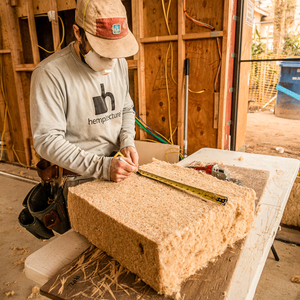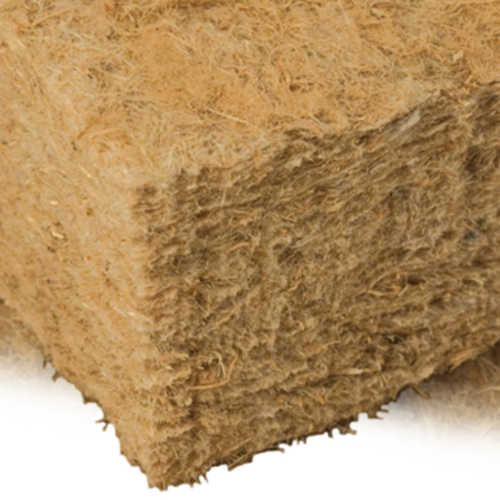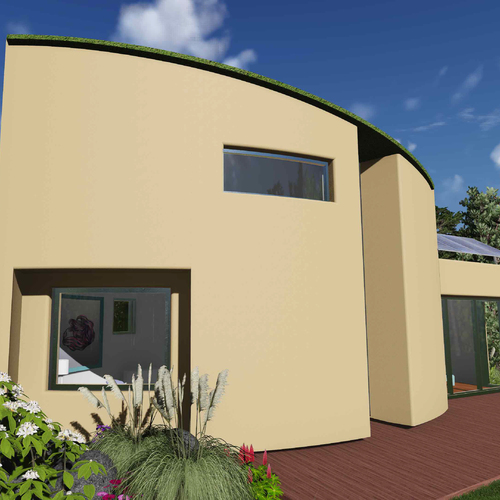
This post originally appeared at Ensia.
It has become almost a cliché to discuss the benefits of hemp, the supposed wonder plant with almost endless uses—from woven fibers to edible seeds to bioplastics. “Of course, hemp is that magic crop that does everything,” says Nicholas Carter, an environmental researcher who, along with Tushar Mehta, a Toronto-based doctor, runs the website Plant Based Data.
His work involves reading through scientific papers and studies and summarizing the most important work supporting plants as a source of food and other important uses. Given the hype, Carter wondered just how much power hemp really has. “I wanted to see the research out there on it, to see what’s actually real, what’s actually backed by evidence,” he says.
Magic? Not exactly. But Carter came away from his attempted debunking a hemp believer. And one of the most promising of its many uses, he found, is its application as a building material known as hempcrete.
Like its namesake concrete, hempcrete is a material mixed with a binder that hardens it into a solid in the form of blocks and panels. Made from the dried woody core of hemp stalks and a lime-based binder, hempcrete can be cast just like concrete. But unlike concrete and its binding cement, which accounts for about 8% of human-generated carbon dioxide emissions annually, hempcrete actually sequesters CO2. According to a recent study, hempcrete can sequester 307 kilograms of CO2 per cubic meter (19 pounds per cubic foot), roughly the equivalent of the annual carbon emissions of three refrigerators.
“While we’re growing it and building hempcrete, it’s sucking CO2 the whole time and encapsulating the CO2 in the structure,” says Eric McKee, founder of the U.S. Hemp Building Association.
Hempcrete outperforms many standard materials
S.R. Karade, senior principal scientist of the Central Building Research Institute in Roorkee, India, outside New Delhi, has been studying hempcrete and wrote in a recent paper for the Journal of Cleaner Production about how hempcrete performs as a building material in terms of insulation, durability, structural strength and acoustic control, among other criteria. Overall, Karade found, hempcrete meets the current standards of most building applications and in many cases outperforms materials currently used, particularly for insulation.
Hempcrete is not a direct replacement of concrete, Karade cautions. In the lab he’s been able to make hempcrete with a compressive strength of 3 megapascals (MPa). “Typical concrete blocks, used for making walls, have compressive strength values varying between 5 MPa and 20 MPa,” he wrote in an email. “Due to its poor mechanical strength, it cannot be sufficiently relied upon to undertake any structural loads. However, considering its impressive functional properties, in terms of thermal resistance and [moisture-absorbing] behavior, hemp concrete may be at the top spot in the list of walling materials in the future.”

In other words, it can’t supply the load-bearing structure of a building, but it can insulate and cover its walls.
That’s part of what makes hempcrete such a potentially transformative building material, says Steve Allin, director of the International Hemp Building Association. Not only can hempcrete itself sequester carbon, but its use can help reduce the production of more CO2. “What’s really important about this material is we can create new structures or we can update or retrofit existing structures so that they don’t need air conditioning,” Allin says.
As Karade notes, hempcrete has a high thermal capacity compared with concrete, making it good for both the structure of a wall and its insulation.
Reducing construction waste
Hempcrete can also cut down on another big problem: construction waste. Concrete represents more than half of the debris generated by building construction and demolition. The U.S. Environmental Protection Agency estimates that more than 23 million tons (more than 20 million metric tons) of concrete debris were created during construction in 2015. And while hempcrete can’t be used for structural sections of a building, it can be used to replace non-structural elements of walls that traditionally could use concrete. Hempcrete can also be used in place of common construction materials like drywall and plaster, which account for about 8% of building construction debris.
Allin says builders are beginning to see value in hempcrete. Buildings have been built or renovated with hempcrete in France, the U.K., Belgium, Ireland, the Netherlands, Italy and Australia. He says the British Science Museum Group’s artifacts storage facility used hempcrete, as have public housing towers and even renovations on stone buildings hundreds of years old.
The challenge, he says, is availability. There are only about a dozen hemp processing plants that are able to process hemp into a form usable in the creation of hempcrete, and most are in Europe, according to Allin. “That’s really the logjam,” he says. “What we really need is investment in primary processing. And that investment needs to be on the longer term, rather than people expecting quick returns and thinking of it as some other standard quick buck.”
Legal challenges remain
But laws are beginning to change. In the U.S., the 2018 Farm Bill allows for the broad cultivation of “industrial hemp,” but with tight restrictions on grower licenses and the crop’s psychoactive content, tetrahydrocannabinol, or THC.
Weekly Newsletter
Get building science and energy efficiency advice, plus special offers, in your inbox.















17 Comments
I'm confused. If it can't replace concrete, why all the comparisons to concrete? If the idea is to use it as an insulating material, how does it compare to other insulating materials?
Exactly. It's just a VERY expensive insulation material.
If seen through that lens, then yes. But you're looking at it way too narrowly. It's thermal insulation, but not just that. It's also acoustic insulation, a vapor control layer, and thermal mass. Also, it can't support load but it can support itself and a layer of stucco or other finish - what other "insulation" product can do that? Just swapping it in for fiberglass batts would dramatically underutilize the material. You need to think more creatively.
Brent,
I don't think having Charle and Granular thinking about Hemp more creatively is what will make any difference. It's the manufacturers who need to produce sample building assemblies, get code approval for them, and produce products in various commodity forms that are readily available. That's what will determine whether it becomes widely used or not. That's the same problem that faces almost all alternative materials. T-Studs, insulated CMUs, straw-bale, etc.
It's not quite like anything else so they compare it to concrete because that's what it seems to resemble. It's most like an insulation material, but it can also make sheathing, air and vapor control layers unnecessary. You couldn't fault cellulose or wood fiber insulation for not being structural. Its R-value per inch is not super high, comparable to straw insulation, but because it can safely absorb and release moisture without negative effect, it works as a phase-change material which increases its insulating value beyond what R-value testing would show. If you're looking for the lowest-cost way to build a decent house, I wouldn't consider hemp at this point. But I'm looking into it for projects for its other benefits.
Michael,
I think it probably has a lot of potential for the uses you list (I'd me most excited to see another option for rigid insulation), it's just a shame the article didn't emphasize them.
Most confusing for me was the assertion that although it can not replace structural concrete walls, it can replace non-structural ones. Who uses concrete for non-structural walls?
Malcolm,
Non-structural concrete masonry walls are all too common in commercial construction, particularly for fire barriers, shafts and parking enclosures. I'm curious about the fire resistance properties of hempcrete and if it could be a substitute for non-bearing CMU.
Jason,
That would be an interesting alternative use. I wonder about finishes though? One of the advantages of CMU walls it they are smooth and only need to be painted, making them ideal for shafts, and partitions for mechanical rooms, corridors etc.
From Canada, and especially from Alberta, this discussion seems a bit behind the times. This company built a big fancy house on Vancouver Island that was quite well publicized: https://justbiofiber.com/
The Alberta Council of Technologies and the Agriculture and Food Council of Alberta have been hosting an annual Industrial Hemp Conference to bring hemp producers, processors and innovative businesses together with anyone interested.
It has been an emerging industry for quite a while, did the chicken or the egg come first? Doesn't matter, there is supply and the demand now and the move and drive to make it practical. Close to 40,000 hectares were registered in 2019, about half that in Saskatchewan and about 10,000 ha. in Alberta. A good start and poised for growth. I believe the agricultural community can adapt at least as quickly as the building industry, it's fantastic that we are able to learn together.
The question about finishing brings up the question of labor, as the stuff can be plastered on in different grades for interior or exterior surfaces smooth or not so smooth. Around here it is hard to find people who can plaster well. Considering the benefits for new builds or retrofits, and the revolutionary nature of the work I suspect a workforce will emerge. -Doug Beck
I got high just reading this article.
Seriously, there are so many good solutions and ideas out there that don't get implemented, is it possible that powerful interests don't want to allow them?
Marc,
Maybe, or maybe the answer is a lot more prosaic.
Of course in any market incumbents protect their position, but what largely determines whether new materials or techniques catch on is pretty basic: It helps if they are easily adapted to the way buildings are currently constructed, and they need to be widely available in commodity form, not sourced from small manufacturers with different proprietary products and processes.
Without the possibility of those two things, they usually don't get far enough to worry the "powerful interests".
Malcom, I'll disagree on what largely determines. What about the law? And the building code? Who wrote those? And to whose benefit? Obviously, they are written by the powerful to protect their interests, and the environment be damned.
This is what is so ineffective and superficial about the conversation. Over and over we regurgitate all the wonderful things we could be doing. We refuse to acknowledge the ptb and what they're up to. No, I'm not a conspiracy theorist, I'm an analyst, and I use the state of our planet as evidence.
The construction industry is highly risk-averse as are code enforcement officials. New building methods and materials have to overcome a lot of inertia and skepticism to gain widespread use and approval. Higher risk equals higher cost. Find a workforce willing to try new things and owners to foot the bill and it'll happen, just likely not at the speed one would like.
Marc,
Why not use concrete examples?
Look at T-studs. They have got code approvals. What stops the widespread adoption of them as framing materials? It's not "powerful interests", it's availability and price. I'd be interested in an example of something you think is in the building code because of lobbying, or something which has been excluded for no good reason.
The materials I use to build a house to lockup almost without exception come from two sources: the concrete batch plant, and my lumberyard. What's stopping me from using exotic unproven products from small producers? The competitive nature of the construction business (that is, I want to feed my family), and that I am risk adverse (I don't want to lose my own house to a lawsuit). If you think I'm furthering the interests of some evil cabal, I can live with that.
"If you think I'm furthering the interests of some evil cabal, I can live with that."
Of course not! I think both our points have validity.
This may be a concrete example. An electrician friend of mine once said to me that the electrical code in BC was largely written by industry. If you look at the astounding number of bits and pieces that go into an installation in BC, it's easy to imagine the industry wrote the code to sell product, i.e. wires have to be stapled minimum every 5' and terminate in a box. I worked framing a job here in NZ where boxes are not used and wires are only stapled to locate their terminus. Building practices are quite different here, btw. Like no air barrier, unbelievable.
Marc,
I've done a fair amount of wiring here in BC, and with the exception of maybe the requirement for Arc fault outlets, I can't think of anything that doesn't make sense to me.
The requirement for attachment every five feet is related to the understandable aim of keeping all wires 1.25" from the face of any framing for protection from mechanical damage from fasteners.
Boxes provide both protection for splices and junctions as well as a mounting surface for switches and outlets. I struggle to see how you could safely and efficiently wire without them, except for the few appliances where they are provided as part of the fixture (dishwashers, baseboard heaters) - and in that case they aren't required by our codes.
One of the main reasons the risk of fire is so much lower in new construction than in older homes has been the adoption of safer practices in electrical codes. I'm not trying to be difficult, but I don't agree that the primary driver for these has been to benefit any vested interests.
I'm not saying it's the primary driver, but it can't be discounted. And nothing wrong with the BC code, I prefer it.
Log in or create an account to post a comment.
Sign up Log in